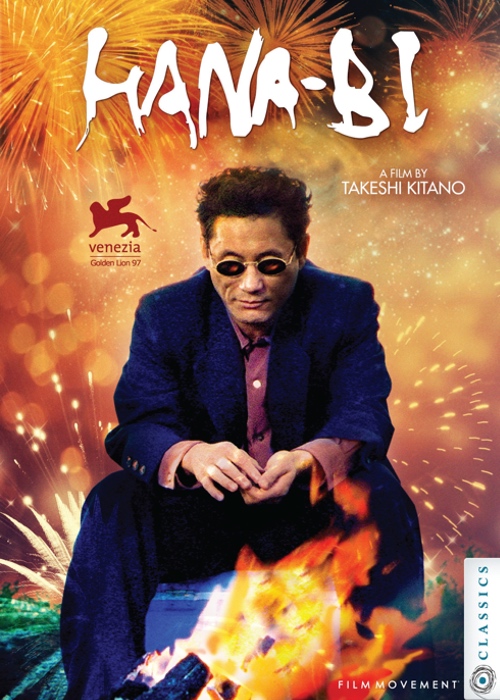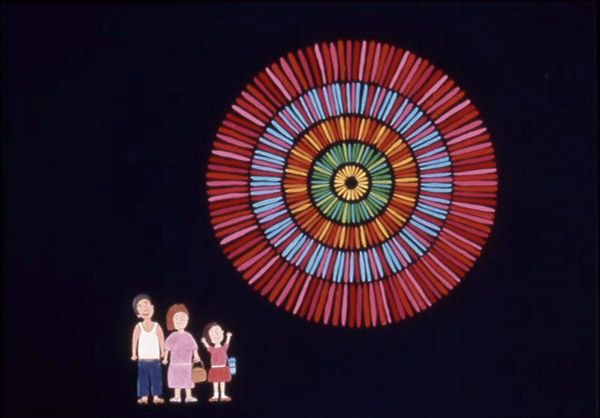fireworks
wholesale market
Jan. 10, 2023
The creative team of SuperFireworks Co., Ltd. continues "The Art of Fireworks and Fireworks in Art" series. In each issue of this series, we bring to your attention examples from various forms of art where pyrotechnics was mentioned or used.
***
Cinematography: Hana-bi (1997)
A 1997 Japanese crime drama film Hana-bi (which is the Japanese word for "fireworks") is written, directed and edited by Takeshi Kitano, who also stars in it. Hana-bi won the Golden Lion at the 54th Venice International Film Festival and helped to establish Kitano as an internationally acclaimed filmmaker. (Strange as it is, but it was not until Kitano won the Golden Lion that he was accepted as a serious director in his native Japan; his prior films had been looked at as just the hobby of a famous comedian).
American film critic Roger Ebert rated it three stars out of four, citing its unusual approach toward serenity and brutality, calling it "a Charles Bronson Death Wish movie so drained of story, cliché, convention and plot that nothing is left, except pure form and impulse."
The film tells the story of a beleaguered police detective Nishi, who confronts the yakuza in order to help the widow of a murdered colleague and a paralyzed friend. Together with his wife suffering from leukemia, he goes on the last idyllic journey through Japan, though his path happens to be paved with nihilism and violence.
Despite the movie’s title, fireworks are shown in the film in a just a single scene, which, however, perfectly conveys the mood of what is happening and the auteur's immense talents both in front of and behind the camera.

***
Painting: Takeshi Kitano, Fireworks (1994-1997)
In Takeshi Kitano’s Hana-bi, when Nishi’s partner Horibe is shot and paralysed, he is quickly deserted by his family. Alone, jobless, and bored, he is eventually driven to an unsuccessful attempt at suicide. Nishi sends Horibe a package of art materials; after recovering from the failed suicide, Horibe slowly embarks on a series of paintings. The pictures are skilfully woven into the film’s surface, becoming a poignant counter-point to Nishi’s journey, as he attempts to overcome his own emotional paralysis. Like the Horibe character, Kitano took up painting when he was immobilised for an extended period following a near-fatal motorcycle accident in August 1994. The paintings that appear throughout the film are Kitano’s own work, produced in the time since the crash.

***
Literature: Natsuki Takaya, Fruits Basket (1998-2006)
Our today’s issue happens to be devoted to Japan, so it is logical to conclude it with the kind of fine arts and literature that was born in the land of the rising sun. Fruits Basket is a Japanese manga series written and illustrated by Natsuki Takaya. It was serialized in the Japanese shōjo manga magazine Hana to Yume from 1998 to 2006. The series' title comes from the name of a popular game played in Japanese elementary schools, which is alluded to in the series.
The Fruits Basket manga series received the 2001 Kodansha Manga Award in the shōjo manga category and the "Best Manga" award at the 2007 American Anime Awards. In 2001, the Fruits Basket anime won an Animage Anime Grand Prix award. Takaya's artwork in particular has been praised by critics, with Takaya's skills in detailed art, shadowing, and shading lauded as able to convey the character's moods and emotions without the character having any dialogue at all.
“Hatsuharu Sohma: We shall go wild with fireworks... And they will plunge into the sky and shatter the darkness.
Yuki Sohma: We don't have any fireworks that big”.
***
Here comes to an end the eighth chapter of our journey into the world of The Art of Fireworks provided by SuperFireworks Co., Ltd!
Stay tuned! Stay super!